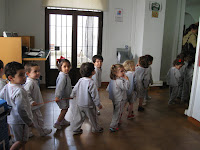
My introduction to Córdoba was a good one. The people at the Tourist Information desk and the taxi driver were friendly and helpful. Plus the rain stopped and it was starting to warm up a little. Things were looking up.
The city map was awful, and I got lost. Apparently, I wasn't alone, because stenciled on a wall was the sign above, Estoy Perdido, which means, I Am Lost.
Because of the cold weather, I had been wearing the same clothes every day, and they were ripe. I handed over my jeans, a t-shirt and a thin sweater to be laundered. When I got them back the next day, the cost was about $15. Arrgh.
I timed my trip to Spain, and to Córdoba in particular, to coincide with the annual Patio Flower Competition. I got a map for the patios that were open to the public to show off their flowers.
 My first stop, though, was at the statue of Maimonides, a 12th century doctor, rabbi and philosopher. Rubbing his foot was supposed to do something - bring luck? erudition? - so I rubbed it, then walked down the street to the sinagoga, one of three (two in Toledo) to survive the Inquisition of 1492.
My first stop, though, was at the statue of Maimonides, a 12th century doctor, rabbi and philosopher. Rubbing his foot was supposed to do something - bring luck? erudition? - so I rubbed it, then walked down the street to the sinagoga, one of three (two in Toledo) to survive the Inquisition of 1492.The patio flower map wasn't much better. I simply could not find some of the patios indicated on the map. I learned that the map used previous years' locations. But I did see many of the patios, and the flower displays were pretty: red and pink geraniums, impatients, hydrangeas and petunias. Coming from Costa Rica, though, where there are gorgeous flowers year-round in my back yard, I was a little disappointed.

Patio Flowers
I walked along the Guadalquivir River, surprised that buildings along the riverfront were not developed as restaurants or for tourism. I was trying to find a patio route, but failed. I stopped at a bus stop and asked a cute young guy for bus help back to my hotel area. He said to take the #4, with him. He was studying economics and enjoyed practicing his rudimentary English with me. As the bus made its way past the municipal building, I saw a crowd of people standing on the street, so I got off to check out what was happening.
 It was the Hermandad de Nuestra Senora del Rocio - an Asuncion Day tope, a romeria (pilgrimage walk). I got to talking with a couple of Dutch couples and a couple from Toledo. I played translator for all of them. The horses and their riders were on parade. The men were dressed in traditional Spanish garb, and the women and girls were wearing beautiful flamenco gowns.
It was the Hermandad de Nuestra Senora del Rocio - an Asuncion Day tope, a romeria (pilgrimage walk). I got to talking with a couple of Dutch couples and a couple from Toledo. I played translator for all of them. The horses and their riders were on parade. The men were dressed in traditional Spanish garb, and the women and girls were wearing beautiful flamenco gowns.
Two Dutch couples and me
The Mezquita/Cathedral was free before 10am. The building itself was just an immense empty hall with pillars, but with an elaborate altar and side rooms devoted to saints. This was built was a church, then became a mosque, then because a church again - a story typical of cathedrals/mosques in southern Spain.
As I was about to take a picture of the ornate altar, I had to change the batteries in my camera. So I put in the new ones that I had brought, but the camera wouldn't work. Oh no! I was halfway through my trip to Spain with a broken camera. I left and went back to my hotel room, which was directly across the street, and tried the second pair of fresh batteries I had brought. They worked! Then I had to hurry back to the cathedral to get in before they started charging money. But the altar had just been roped off to tourists for a real live mass, so that picture was not to be.
 Next on my dwindling list of To Do's in Cordoba was the Alcazar. The map showed it two blocks from my hotel, yet I could not find it. What I did find was the public library, and I went in. It was an old building on the outside, but brand spanking new on the inside. I used the free computers to check my email and bank accounts and to use the bathroom. While I was at the computer, a group of three-year-olds paraded in. They were all attached by a rope and looked between curious and bewildered. They were very cute.
Next on my dwindling list of To Do's in Cordoba was the Alcazar. The map showed it two blocks from my hotel, yet I could not find it. What I did find was the public library, and I went in. It was an old building on the outside, but brand spanking new on the inside. I used the free computers to check my email and bank accounts and to use the bathroom. While I was at the computer, a group of three-year-olds paraded in. They were all attached by a rope and looked between curious and bewildered. They were very cute. Finally I found the Alcazar. The gardens were lovely, and the sun was starting to warm me up and shine on the beauty. There were purple flowers, red poppies, roses, pools, fountains and a statue of three Christian kings who stayed there when they visited Córdoba.
Finally I found the Alcazar. The gardens were lovely, and the sun was starting to warm me up and shine on the beauty. There were purple flowers, red poppies, roses, pools, fountains and a statue of three Christian kings who stayed there when they visited Córdoba.I spent some time sitting in a big plaza called Tendillas, just people-watching. I observed that women don't show off their big breasts with low cleavage here (in Costa Rica, the bigger and barer, the better). Nor do they have big hips or butts. How can they eat white bread and pastry and not have big bottoms?


No comments:
Post a Comment